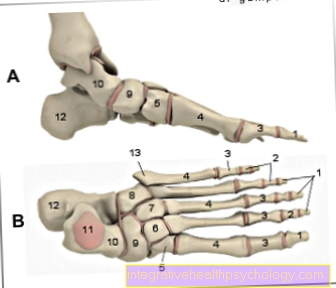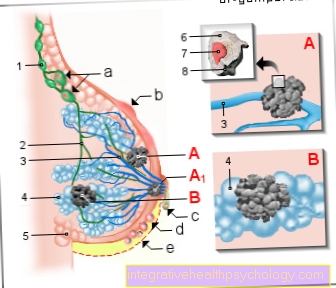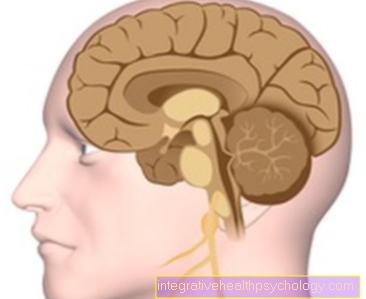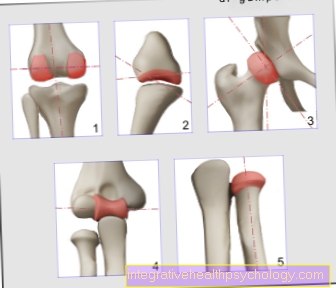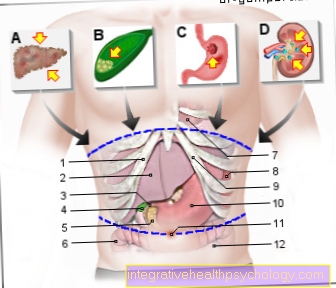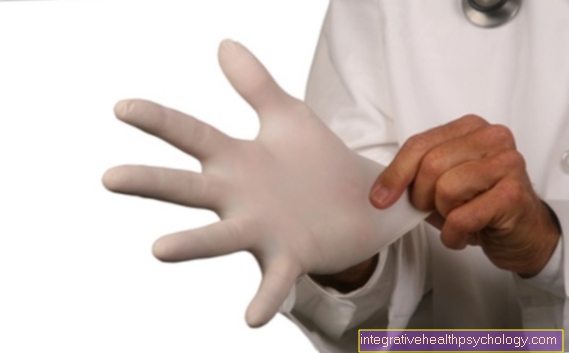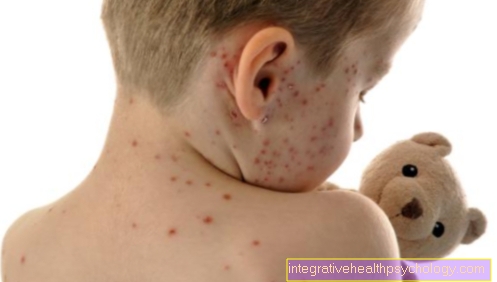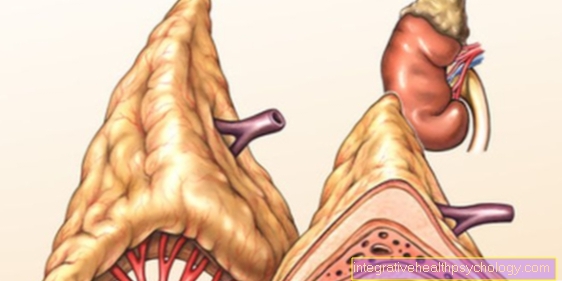Infectious diseases
Infectiology (from Latin infectio, "the infection") is an interdisciplinary field that combines the areas of microbiology and medicine. It deals with the appearance, course and consequences of diseases that are triggered by microorganisms such as bacteria, viruses, fungi, parasites and prions and that can affect all possible organs or the entire body system.
In addition to researching infectious diseases, the task of medical infectiology is to develop and apply measures to prevent, contain, diagnose and treat infectious diseases.

Classification of infectiology
Infectious diseases can be roughly divided into:
- Bacterial diseases
- Viral diseases
- Fungal diseases
- Parasitic diseases
- Prion diseases
In addition, a further division into:
- Infectious diarrheal diseases
- Sexually transmitted diseases
- Infectious childhood diseases
- Nosocomial infections
- Multi-resistant hospital germs
- Blood poisoning (sepsis)
Bacterial diseases

Bacterial diseases or infections in humans are triggered by the penetration of bacteria into the organism, their reproduction within the host and the reaction of the body to them. Bacteria (lat. Bacterium "stick, stick") are single-celled, seedless microorganisms (prokaryotes). They can be distinguished and categorized in many features, such as Dyeability in the Gram stain, shape, arrangement or disease-causing factors.
Not every bacterium causes disease or infection. In humans there are also benign (non-pathogenic) bacteria that do not cause an infection and permanently colonize the skin and mucous membranes ("normal flora"), which protects them from bacteria that cause infection or take over important breakdown processes on the intestinal mucosa as part of digestion. On the other hand, there are also disease-causing (pathogenic) bacteria whose contact with the body leads to disease. But also actually benign bacteria can cause a so-called opportunistic disease if the immune system is weakened.
The typical therapy for bacterial diseases is represented by a wide variety of antibiotics.
Helicobacter pylori gastritis
Read more on the topic on our main page Helicobacter pylori.
Salmonella gastroenteritis
See below Infectious diarrheal diseases - salmonella gastroenteritis.
Campylobacter enteritis
See below Infectious diarrheal diseases - Campylobacter enteritis.
E. coli enteritis
See below Infectious diarrheal diseases - E. coli enteritis.
Pseudomembranous colitis
See below Infectious diarrheal diseases - pseudomembranous colitis.
cholera
See below Infectious diarrheal diseases - cholera.
Whooping cough (pertussis)
See below Infectious childhood diseases - whooping cough (pertussis).
Epiglottitis (inflammation of the larynx)
See below Infectious diseases of children - epiglottitis (inflammation of the larynx).
Diphtheria (true croup)
See below Infectious childhood diseases - diphtheria (real croup).
Scarlet fever
See below Infectious diseases of children - scarlet fever,
Chlamydial infection
Read more on the topic on our main page Chlamydial infection.
Gonorrhea (gonorrhea)
Read more on the topic on our main page Gonorrhea.
Syphilis (syphilis, hard chancre, ulcus durum)
Read more on the topic on our main page Syphilis.
Soft chancre (ulcus molle)
Read more on the subject on our website Soft chancre (ulcus molle).
tuberculosis
Tuberculosis, one of the most common infectious diseases worldwide, is caused by the bacterium Mycobacterium tuberculosis. In most cases it is transmitted via the air via droplet infection and first settles in the lungs of the infected. There the infection either runs without symptoms or there are B symptoms (weight loss, slight fever, night sweats) or a persistent cough with sputum. This condition is called primary tuberculosis or an initial infection. A second infection occurs when the immune system is weakened for whatever reason and the bacterium can attack other organs. The tuberculosis pathogen spreads through the blood system and can theoretically colonize any organ. Diagnostics is made up of many modalities. These include a laboratory examination, an X-ray of the lungs and direct detection of the pathogen using various methods. Since the bacterium has various protective mechanisms, antibiotic therapy must be carried out over a long period of time. The standard regimen includes four different antibiotics that must be taken over two months. Then two of these antibiotics are taken for another four months. Vaccination against tuberculosis is no longer recommended.
Read more on the topic on our main page Tuberculosis.
Borreliosis (Lyme disease)
Read more on the topic on our main page Lyme disease.
Meningococcal meningitis (meningococcal meningitis)
Read more on the topic on our main page purulent meningitis.
Read more on the subject on our website Waterhouse-Friedrichsen Syndrome.
tetanus
Read more on the topic on our main page Tetanus.
Typhus (typhoid salmonellosis)
Read more on the topic Typhoid salmonellosis.
Legionnaires' disease (legionellosis)
Read more on the topic on our main page Legionnaires' disease.
Anthrax (anthrax)
Read more on the topic on our main page Anthrax.
Brucellosis
Brucellosis is caused by the bacterium Brucella melitensis. A distinction is made between different subtypes, depending on which room or which bacterial carrier it is. The most common vector for humans are infected farm animals such as cattle, pigs, goats, dogs, camels and others. In particular, the consumption of contaminated food such as unpasteurized milk carries the risk of infection. Brucellosis is rare in Germany. As a rule, the course of the disease is subclinical (relatively mild), whereby the symptoms are individual. The main symptoms are fever, night sweats, chills and nausea. Standard therapy is the use of antibiotics.
Read more on the topic on our main page Brucellosis.
Viral diseases

Viruses are infectious particles that consist of a strand of DNA or RNA and a protein envelope. As a cellular parasite, they are dependent on a host cell to reproduce and can cause diseases in the human body. Many viral infections can also be symptom-free without being noticed by the person affected. In addition, some virus infections can remain in the body for a lifetime (persistence), such as Herpes infections and only break out under certain conditions, such as an immune deficiency. Transmission is also possible in the symptom-free stage, so that some viral diseases show a high level of infection in the population (e.g. herpes virus, EBV, HPV). The containment is difficult due to z. T. lack of specific therapies.
measles
See below Infectious childhood diseases - measles.
mumps
See below Infectious teething diseases - mumps.
rubella
See below Infectious childhood diseases - rubella.
Ringlet rubella
See below Infectious childhood diseases - rubella.
Three-day fever
See below Infectious childhood diseases - three-day fever.
Hand, mouth and foot disease
See below Infectious teething diseases - hand, mouth and foot disease.
Chickenpox (varicella)
See below Infectious childhood diseases - chickenpox (varicella).
Herpes virus infections
Read more on the topic on our main page Herpes.
Epstein-Barr virus infection (EBV, glandular fever)
Read more about the topic on our website Epstein-Barr Virus and Glandular Pfeiffer fever.
Cytomegalovirus infection (CMV)
Read more on the topic on our main page Cytomegalovirus.
Influenza (flu)
The so-called real flu is caused by the influenza virus. They are transmitted both through direct contact and via droplets in the air. If the virus is then absorbed by the mucous membrane of the respiratory tract, the incubation period ranges from a few hours to a few days. In three quarters of cases, the infection with the influenza virus is mild and can also be symptom-free. The following typical symptoms occur in the remaining cases. Sudden, high fever with chills. In addition, there are headaches and body aches. The patients feel weakened and there is a pronounced feeling of illness. In the course of the disease, a dry cough can develop, which is triggered by inflammation of the bronchi. In addition, low blood pressure and a slowed pulse rate can occur. Influenza flu is diagnosed based on symptoms and a blood test. First, a rapid test is carried out so that, if necessary, therapy can be initiated as quickly as possible. In addition, the genetic makeup of the virus can be detected with a special test and the diagnosis can thus be confirmed. In addition to hydration and fever-lowering measures, the therapy consists of drugs that are aimed directly against the virus and are used especially in severe cases.There is a seasonal vaccination against the influenza virus, which is especially recommended for people with risk factors.
Read more on the topic on our main page Influenza.
Swine flu
Read more on the topic on our main page Swine flu.
Bird flu
Read more on the topic on our main page Bird flu.
Pseudo croup
See below Infectious childhood diseases - pseudocroup.
Human papillomavirus (HPV) infection
Read more on the topic on our main page Human papillomavirus (HPV).
HIV
The human immunodeficiency virus triggers a disease in humans that damages a central part of the immune system and thus leads to an immunodeficiency. The virus can be transmitted through sexual contact, using the same needles when consuming drugs or during childbirth, among other things. There are three stages in the course of the disease. In stage A, there is progressive physical weakness and swelling of the lymph nodes. Flu-like symptoms can also occur. In stage B, other infections that are triggered by various viruses or fungi develop. If there are defined, severe infections or malignant diseases due to the immunodeficiency, one speaks of stage C or AIDS (acquired immunodeficiency syndrome). These infections would not cause any disease in healthy people and only break out in HIV patients because of the immune deficiency. The diagnosis is made in the laboratory and the so-called viral load is determined at the same time, which is decisive for the type of therapy and when to start. Therapy consists of a combination of three drugs that target the virus. If these are taken regularly by the patient, a normal life expectancy can be expected.
Read more on the topic on our main page HIV.
Hepatitis A
Read more on the topic on our main page Hepatitis A.
Hepatitis B.
Read more on the topic on our main page Hepatitis B.
Hepatitis C.
Hepatitis C is caused by the virus of the same name. The disease is transmitted through contaminated needles, for example through drug use or tattooing. But it can also be passed on from the mother to her unborn child. The virus damages the liver in particular and, in untreated cases, leads to chronic liver disease (cirrhosis of the liver). Since this process takes decades, the patients initially notice unspecific symptoms, such as fatigue, fever, abdominal pain and, in some cases, jaundice. Liver cirrhosis, on the other hand, manifests itself with the various symptoms of liver dysfunction (liver insufficiency). The diagnosis is made by means of various laboratory tests of the blood. Among other things, the genetic makeup of the virus is detected in the blood. In acute hepatitis C infection, the drug interferon-alpha is given as therapy. This shows a very good effect, but has serious side effects. The therapy of chronic hepatitis C with the drug interferon-alpha has now been largely abandoned due to the side effects, so that inferon-free therapy schemes (sofosbuvir with ledipasvir or velpatasvir) are the drug of choice with a good chance of success.
Read more on the topic on our main page Hepatitis C..
Hepatitis D
Read more on the topic on our main page Hepatitis D.
Hepatitis E.
Read more on the topic on our main page Hepatitis E.
Norovirus infection
See below Infectious diarrheal diseases - norovirus infection.
Rotavirus gastroenteritis
See below Infectious diarrheal diseases - rotavirus gastroenteritis.
Polio (poliomyelitis)
See below Infectious childhood diseases - polio (poliomyelitis).
Yellow fever
Read more on the topic on our main page Yellow fever.
West Nile fever
Read more on the topic on our main page West Nile fever.
Dengue fever
Read more on the topic on our main page Dengue fever.
Zika virus infection
Read more on the topic on our main page Zika virus.
Ebola
Read more on the topic on our main page Ebola.
Japanese encephalitis
Read more on the topic on our main page Japanese encephalitis.
Rabies
Read more on the topic on our main page Rabies.
Dellar warts
Dellular warts (Mollusca contagiosa, mollusks) are harmless changes in the skin that belong to the group of warts and have a dent in the middle. Dell warts are triggered by a specific virus from the smallpox group, namely the DNA virus Molluscum contagiosum. The warts are very contagious and mostly occur in children and adolescents, and they are mainly found on the eyelids, torso and genitals.
Read more on the topic on our main page Dellar warts.
smallpox
Read more on the topic on our main page Smallpox.
Fungal diseases

Fungal diseases (mycoses) are infectious diseases caused by fungi. In healthy people with a functioning immune system, it usually occurs only to localized infections that can be treated with local antimycotics. Is the immune system weakened, e.g. In the case of an HIV infection or cancer, the fungi can penetrate the blood and cause severe infections (e.g. sepsis or meningitis).
Fungi that can cause diseases in humans can be classified as follows:
- Dermatophytes (thread fungi, e.g. Trichophyton)
- Yeasts (fungi, e.g. Candida albicans)
- Molds (e.g. Aspergillus fumigatus)
Read more on the topic on our main page Fungal diseases.
Skin fungus
Read more about this on our main page Skin fungus.
Bran lichen (Pityriasis versicolor)
Read more about this on our main page Pityriasis versicolor.
Nail fungus
Read more about this on our main page Nail fungus.
Athlete's foot
Read more about this on our main page Athlete's foot.
Hand fungus
Read more about this on our main page Hand fungus.
Candidiasis
This term is a collective term for infectious diseases caused by fungi of the genus Candida. If only the skin and mucous membrane are affected, one speaks of the so-called thrush, whereby here, too, further differences can be made. Infectious fungal species are usually not able to overcome the immune defense in a healthy person or are themselves partly part of our "normal" flora. "In the case of immunosuppression, however, be it innate or acquired, our immune system is no longer in that Position all pathogens in check and this can lead to various infections, including those with organ involvement.
Read more about this on our website Candidiasis.
Vaginal fungus
Read more about this on our main page Vaginal fungus.
Mold allergy
Read more about this on our main page Mold allergy.
Parasitic diseases

Parasites are life beings in the various forms of appearance that depend on a host, so that this represents the basis of life and reproduction. The benefit distribution is on the part of the parasite, while the host is harmed to a certain extent. One differentiates roughly
- Protozoa (single-cell parasites such as Plasmodia (malaria pathogens), toxoplasmas, trypanosomes or amoebas)
- Helminths (multicellular parasites such as various worms)
- Athropoda (ectoparasites such as ticks, mites, fleas or lice)
Read more on the topic on our main page Parasites of humans.
malaria
Read more on the topic on our main page Malaria.
Toxoplasmosis
Read more on the topic on our main page Toxoplasmosis.
Chagas disease
Read more on the topic on our main page Chagas disease.
Amoebic dysentery (amebiasis)
See below Infectious diarrheal diseases - amoebic dysentery (amebiasis).
Giardiasis (Lambliasis)
See below Infectious diarrhea - giardiasis (lambliasis).
Fox tapeworm
Read more on the topic on our main page Fox tapeworm.
Read more on the topic on our main page Worms in the intestines.
Ticks
Read more on the topic on our main page Tick / tick bite.
Scabies
Scabies describes a parasitic skin disease caused by itch mites. This is a very infectious disease that mainly affects is transmitted through direct physical contact from person to person or via shared textiles. The scabies mite nests in the top layer of the skin, leaving behind eggs and balls of feces that are followed by a reaction. Those affected complain of itching (especially at night) and rashes with small red comma-shaped skin changes (especially on the spaces between the fingers and toes). The scabies can be treated very well with medication (so-called anti-itch preparations). It is particularly important to renovate textiles and avoid prolonged skin contact with those affected until the treatment is complete.
Read more on the topic on our main page Scabies.
Fleas
Read more on the topic on our main page Fleas.
head lice
Read more on the topic on our main page Head lice.
Pubic lice
Read more on the topic on our main page Pubic lice.
Bed bugs
Read more on the topic on our main page Bed bugs.
Prion diseases

Prions are infectious, misfolded proteins that are able to transfer normally folded proteins into a misfolded structure, which leads to the destruction of nerve cells and triggers the disease.
Creutzfeld-Jakob disease
An example of this very rare prion disease is Creutzfeld-Jakob disease (human spongiform encephalopathy). The death of nerve cells leads to mental abnormalities, dementia, visual disturbances and movement disorders, later on to severe inhibition of impulses with silence. There is no cure and the disease is quickly fatal if it breaks out.
Infectious diarrheal diseases

Diarrhea (from Greek: "diárrhoia) describes the frequent defecation (more than 3 / day) of watery stools or an increased amount of stool. It can be a symptom of many diseases, but most often through an infection with pathogens. Often one runs acute diarrheal illness is easy and heals independently without the need for medication. Symptom-related therapy with sufficient fluid and electrolyte intake is usually sufficient to compensate for the losses.
With infectious diarrhea, especially those caused by bacteria or viruses, there is a risk of infection and spread within the population. As a result, measures to protect the environment are necessary. For many diarrhea pathogens, there is also a reporting requirement in Germany.
Read more on the topic on our main page Diarrhea.
Salmonella gastroenteritis
Salmonella are bacteria that can be found in foods such as Can stop poultry, eggs or milk. Insufficient heating of these foods can result in salmonella being absorbed into the body with food. However, only a very high number of ingested Salmonella leads to an actual infection. Small doses are blocked by the immune system without causing symptoms. The typical symptom of salmonella gastroenteritis is massive vomiting diarrhea. The diarrhea is watery to bloody. Such an infection can only be life-threatening in people with a restricted immune system. This group of patients is treated with antibiotics. All other patients with an intact immune system should not receive antibiotics, as otherwise the risk of developing new resistance is too high.
Read more on the topic on our main page Salmonella.
Campylobacter enteritis
Campylobacter jejuni is a bacterium that can be found in contaminated food, e.g. in poultry or drinking water. If food is not heated sufficiently, the bacterium survives and can be absorbed into the body and even a few bacteria lead to an outbreak of infection. The incubation period, i.e. the time between infection and the appearance of the first symptoms, is around 2-6 days. The first symptoms can be similar to those of the flu. You present yourself with headache and body aches, fatigue and fever. Then watery diarrhea can develop, which is partly can also occur "explosively". This diarrhea can cause abdominal cramps and in some cases be mixed with blood. Symptomatic therapy, which focuses on the replacement of fluids and electrolytes, is sufficient for many disease courses. Antibiotics can be used in severe cases. The complications of Campylobacter enteritis are reactive arthritis, which is an inflammatory disease of the joints, or Guillain-Barré syndrome. This syndrome is associated with inflammatory damage to the nervous system, which leads to progressive paralysis.
E. coli enteritis
Read more on the subject on our website E. coli enteritis.
Pseudomembranous colitis
Pseudomembranous colitis is severe inflammation of the lining of the colon caused by the bacterium Clostridium difficile and usually occurs as a result of antibiotic therapy. The main symptom of this condition is massive, watery, foul-smelling diarrhea that may contain blood.
Read more on the topic on our main page pseudomembranous colitis.
cholera
Cholera is a serious infectious disease that mainly causes violent diarrhea, described as rice water-like. What is particularly dangerous is the great loss of fluid with 20-30 watery stools per day. The disease is triggered by Vibrio cholerae.
Read more on the topic on our main page Cholera.
Norovirus infection
The norovirus causes an infection with severe diarrhea and vomiting in humans. The virus is very infectious and is transmitted faecal-orally or via aerosolized pathogens in the air. Faecal-oral transmission occurs mostly through hands contaminated with vomit or stool. If the hand that is infected with the virus then comes into contact with the oral mucosa (e.g. when eating with the hands), the virus can trigger an infection. The symptoms of an infection are typically nausea and gushing vomiting in combination with watery diarrhea. In addition, abdominal pain, headache and a feeling of illness can occur. Fever is rather atypical. The symptoms subside within 12 to 48 hours. In the elderly, newborns and small children, the high fluid loss poses a serious risk. The norovirus infection is diagnosed on the basis of the typical symptoms. More extensive examinations, such as examining the stool, are not useful, as this does not have any consequences for the therapy. The therapy is aimed solely at the symptoms; direct control of the virus is not possible. The most important pillar of therapy is the administration of fluids and electrolytes. If necessary, medication can be taken against the nausea.
Read more on the topic on our main page Norovirus.
Rotavirus gastroenteritis
The inflammation of the gastrointestinal tract caused by the rotavirus is particularly dangerous for small children. It is transmitted through direct contact with infected stool or vomit or through contaminated food. Just a few particles of the virus are enough to trigger an infection. Symptoms start suddenly with watery to slimy diarrhea and vomiting. Abdominal pain and fever are also typical, as are symptoms in the respiratory tract in half of all cases. The greatest danger with this infection is the great loss of fluid, which can quickly become life-threatening, especially in small children and old people. The diagnosis is made based on the clinical appearance. Further diagnostics, such as stool samples, are only used when dealing with an epidemic. Therapy is focused solely on the symptoms. Sufficient replacement of fluids and electrolytes is the most important therapeutic measure. In addition, medication against vomiting can be given, but these should be dosed carefully. There is an oral vaccination for infants. This consists of three vaccine doses and should be completed before the age of 6 months.
Amoebic dysentery (amebiasis)
Amoebic dysentery is a serious diarrheal disease that occurs mainly in tropical and subtropical regions. This disease is triggered exclusively by the amoeba genus Entamoeba histolytica.
Read more on the topic Amoebic dysentery.
Giardiasis (Lambliasis)
Giardiasis or lambliasis is an infectious disease caused by the unicellular parasite Giardia lamblia. It occurs more frequently in the tropics and subtropics and spreads there, for example, via contaminated drinking water. In Europe, it is often diagnosed after traveling. The disease can either be symptom-free or trigger high-fat, frothy diarrhea. In addition, flu-like symptoms can occur and there is a risk of the disease becoming chronic. The consultation with a doctor plays an important role in the diagnostic work-up, since information about a trip abroad can be used to search for the parasite in the stool, whereas this would not be a common diagnostic measure for diarrheal diseases without a trip abroad. The therapy consists of the substitution of fluids and electrolytes and antibiotic therapy with the active ingredient metronidazole.
Infectious childhood diseases

Read more on the topic Childhood diseases.
Whooping cough (pertussis)
Whooping cough is caused by a bacterium called Bordetella pertussis. The transmission takes place via droplets in the air. The disease has three stages, but these cannot always be separated from one another. First of all, there are unspecific cold symptoms and possibly conjunctivitis. In the second stage, the eponymous coughing fits occur, which are followed by deep inhalation phases. The tongue is stretched forward and mucus is choked out or even vomited. Bleeding of the conjunctiva of the eye is also possible. In the third stage the symptoms subside, but the cough can persist for many weeks. Since the symptoms are very typical for this clinical picture, the diagnosis can be made on the basis of a consultation with a doctor. In unclear cases, the pathogen can be detected in the laboratory. The therapy consists of measures to widen the airways and antibiotic therapy. There is a vaccination against whooping cough in four doses, which in combination with the tetanus and diphtheria vaccination should be completed before the child is one year old.
Read more on the topic on our main page Whooping cough.
Epiglottitis (inflammation of the larynx)
Epiglottitis (inflammation of the epiglottis) is an acute, life-threatening disease that is usually caused by the bacterium Haemophilus influenza type B (Hib). However, other bacteria can also be used. The age peak is in children between 2 and 7 years of age, whereby seniors and unvaccinated adults are also at risk of developing epiglottitis. As a result of the infection, the epiglottis can swell strongly due to the inflammation, so that in the worst case, breathing is hindered to such an extent that intensive medical care is necessary. Epiglottitis must therefore always be treated as an emergency. Since the introduction of the vaccination against Hib, the disease has become rarer.
Read more on the topic on our main page Epiglottitis.
Diphtheria (true croup)
Read more on the topic on our main page Diphtheria.
Pseudo croup
Read more on the topic on our main page Pseudo croup.
Scarlet fever
Read more on the topic on our main page Scarlet fever.
measles
Read more on the topic on our main page Measles.
mumps
Read more on the topic on our main page Mumps.
rubella
Read more on the topic on our main page Rubella.
Ringlet rubella
Read more on the topic on our main page Ringlet rubella.
Three-day fever
Read more on the topic on our main page Three-day fever.
Chickenpox (varicella)
Chickenpox results from an infection with the varicella zoster virus. They occur more frequently in childhood and the viruses are transmitted via droplets in the air. Chickenpox is therefore highly contagious. Before the typical skin symptoms occur, the patients show non-specific symptoms, such as fatigue or a slight fever. In the initial phase, fluid-filled blisters (vesicles and papules) appear on the reddened skin. The liquid becomes cloudy over time and scabs and crusts form. It is typical to see the different manifestations of the rash side by side. The hairy skin is also involved and there is severe itching. In patients with a normal immune system, the vesicles heal within a week. In immunocompromised people, an infection with chickenpox can take on a complex course. The diagnosis is usually made based on the symptoms. Therapy consists of skin care and possibly anti-itch medication. An antiviral drug can only be used in the event of a risky course, for example in newborns or people with an immunodeficiency. There is a live vaccination against the virus with two doses, which is recommended in early childhood.
Read more on the topic on our main page Chickenpox.
Hand, mouth and foot disease
Read more on the topic on our main page Hand, mouth and foot disease.
Polio (poliomyelitis)
Polio (poliomyelitis, "polio") is caused by polioviruses. In the past, polio was considered a dreaded disease in childhood due to paralysis that could not be reversed. The disease has now become very rare thanks to global vaccinations. The reason for the symptoms of paralysis is the virus infestation of muscle-controlling nerve cells in the spinal cord. The clinical picture can be very different: from mild or symptom-free clinical pictures to pronounced flaccid paralysis, especially of the legs. In the worst case, the muscular swallowing apparatus or the respiratory muscles are affected by the paralysis with fatal consequences. There is no specific therapy. However, some of the paralysis can regress again.
Read more on the topic on our main page Poliomyelitis.
Sexually transmitted diseases

Sexually transmitted diseases (STD) is a collective term for infectious diseases caused by viruses, bacteria, fungi or parasites that are mainly transmitted through sexual contact. Symptoms are usually discharge from the vagina or urethra, pain in the genitals or in the lower abdomen. But a symptom-poor to symptom-free course is also common, which favors the rapid spread if contraception with a condom is not used.
The most common sexually transmitted diseases include:
- Mycoses (e.g. vaginal fungus)
- Genital herpes
- Genital warts (condylomas, HPV)
- Chlamydial infection
- Gonorrhea (gonorrhea)
- Syphilis (syphilis, hard chancre, ulcus durum)
- HIV
- Hepatitis B.
- Trichomad colpitis
- Pubic lice
- Soft chancre (ulcus molle)
- Inguinal lymphogranuloma
You can find an overview of the most common sexually transmitted diseases on our main page STDs.

